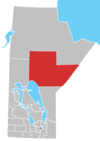Red Sucker Lake First Nation
| People | Oji-Cree |
|---|---|
| Treaty | Treaty 5 |
| Headquarters | Red Sucker Lake, Manitoba |
| Land | |
| Main reserve | Red Sucker Lake 1976 |
| Government | |
| Chief | Samuel Knott[1] |
| Tribal Council | |
| Island Lake Tribal Council | |
Red Sucker Lake (Oji-Cree: Mithkwamepin Thaakkahikan, ᒥᐢᑾᒣᐱᐣ ᓴᑲᐦᐃᑲᐣ) is an Oji-Cree First Nation in Manitoba, Canada, located about 706 km (439 mi) northeast of Winnipeg. As of December 2021[update], the registered population was 1,178 of which 953 lived on their own reserve.[2]
Its main reserve is Red Sucker Lake 1976, which contains the community of Red Sucker Lake, Manitoba.
Historically, the peoples of Red Sucker Lake were part of the Island Lake Band, which also included nearby First Nations of Garden Hill, St. Theresa Point, and Wasagamack. They are a signatory to the 1909 adhesion to Treaty 5.
History
Red Sucker Lake First Nations once belonged to the Island Lake band,[3] who, on 13 August 1909, became a signatory of Treaty 5. In 1969, Island Lake split into four separate communities with their own separate administrations: Garden Hill, Wasagamack, St. Theresa Point First Nations, and Red Sucker Lake.[4] Today, the four communities have a Tribal Council, called Island Lake Tribal Council,[5] to collaborate on common interests.[4][6]
Reserves
The First Nation has eight reserves:[2]
| Reserve[2] | Coordinates[7] | Total area | Notes |
|---|---|---|---|
| Red Sucker Lake 1976 | 54°9′39″N 93°34′10″W / 54.16083°N 93.56944°W | 252.60 ha (624.2 acres) | Serves as the First Nation's main reserve and contains the community of Red Sucker Lake, Manitoba. It is located 224 km (139 mi) from the city of Thompson |
| Red Sucker Lake 1976 A | 54°9′11″N 93°29′44″W / 54.15306°N 93.49556°W | 1,729.90 ha (4,274.7 acres) | |
| Red Sucker Lake 1976 B | 54°6′27″N 93°31′57″W / 54.10750°N 93.53250°W | 1,069.30 ha (2,642.3 acres) | |
| Red Sucker Lake 1976 C | 54°12′24″N 93°52′13″W / 54.20667°N 93.87028°W | 443.60 ha (1,096.2 acres) | |
| Red Sucker Lake 1976 D | 54°10′20″N 93°47′14″W / 54.17222°N 93.78722°W | 57.90 ha (143.1 acres) | |
| Red Sucker Lake 1976 F | 54°5′58″N 93°43′43″W / 54.09944°N 93.72861°W | 28.40 ha (70.2 acres) | |
| Red Sucker Lake 1976 G | 10.90 ha (26.9 acres) | ||
| Red Sucker Lake 1976 H | 129.90 ha (321.0 acres) |
Governance
The First Nation elect their officials through the Custom Electoral System. Their council consists of a Chief and six councillors.[2]
The First Nation maintains political affiliations with the Island Lake Tribal Council (ILTC), Manitoba Keewatinohk Okimahkanak (MKO), Assembly of Manitoba Chiefs (AMC), and Indian and Northern Affairs Canada (INAC).[2]
Notable people
See also
References
- ^ Laychuk, Riley (December 14, 2020). "Community 'still panicking' as military arrives in Red Sucker Lake First Nation amid COVID-19 outbreak: chief". CBC News. Retrieved August 28, 2021.
- ^ a b c d e Indigenous and Northern Affairs Canada (14 November 2008). "Red Sucker Lake | First Nation Detail". AANDC. Retrieved 2024-02-25.
- ^ "About Us". St. Theresa Point First Nations. Retrieved 2021-08-18.
- ^ a b "First Nation History". St. Theresa Point First Nations. Retrieved 2021-08-18.
- ^ "Island Lake Tribal Council Inc". Crown–Indigenous Relations and Northern Affairs Canada. Government of Canada. 2019-04-09. Retrieved 2021-08-18.
- ^ "AANDC (Registered Population)". Crown–Indigenous Relations and Northern Affairs Canada. Government of Canada. 14 November 2008. Retrieved 2015-01-14.
- ^ "Search Results for Red Sucker Lake". Government of Canada. Retrieved August 28, 2021.

